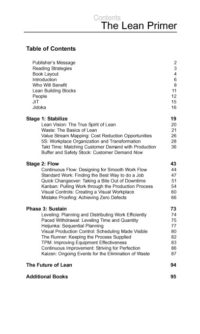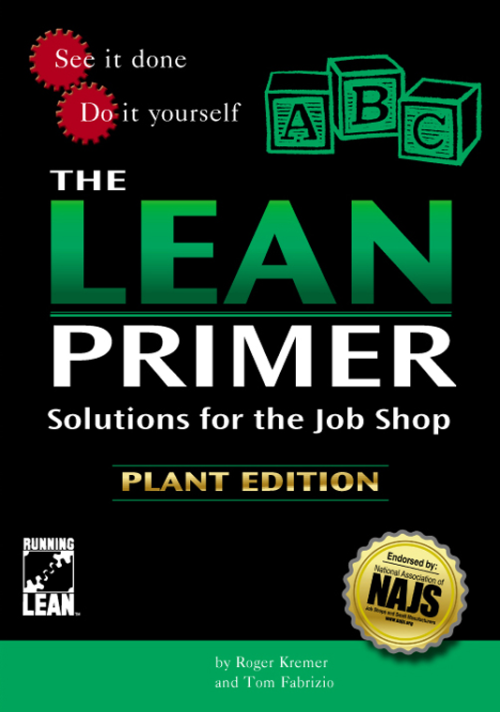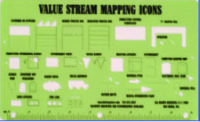By: Roger Kremer and Tom Fabrizio
The Lean Primer will allow you to train the organization to understand how critical the implementation of Lean principles and processes are to your short and long term success. It will provide the various reasons why an organization must go Lean, as well as detailing what Lean is. Lean will be explained in the terms of Stabilize, Flow, and Sustain with reference to the following topics of lean vision, waste, value stream mapping, 5S, takt time, buffer and safety stock, continuous flow, standard work, quick changeover, kanban, visual controls, mistake-proofing, leveling, paced withdrawal, visual production control, runners, TPM, and kaizen. Each of these tools will also be explained with digital photos from world-class shops from across the US that shared their best practices.
-
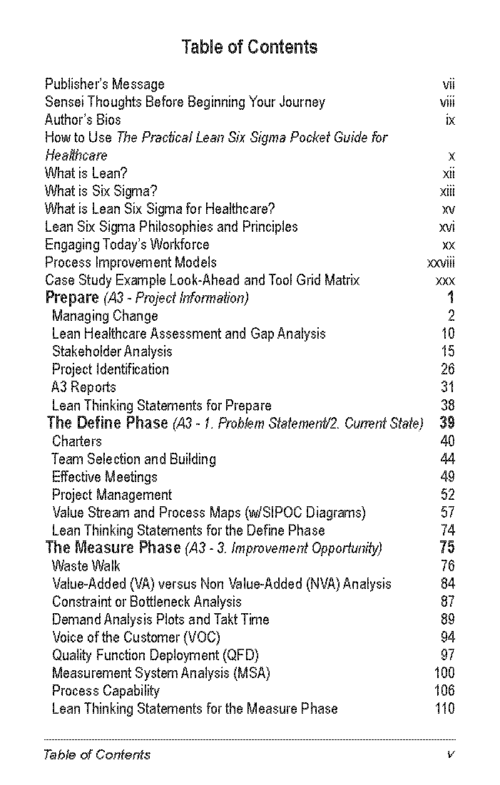
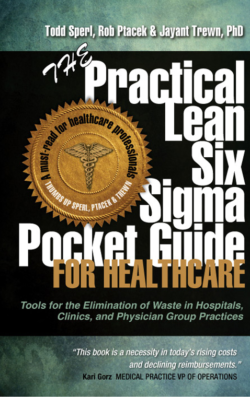 By: Todd Sperl, Rob Ptacek, Jayant Trewn (PhD) This book bridges the gap between a highly quantitative analysis of a process that requires extensive training (i.e., Six Sigma certification) and a more simplified approach that can be used and understood by the masses (i.e., Lean thinking). The goal of this book is to make the methods and tools of Lean and Six Sigma accessible to more people and provide a common sense or “practical” approach to problem solving and continuous improvement. This book is intended to be used by Sigma Belt Levels, Lean Senseis (i.e., teachers), Continuous Improvement Specialists, front-line managers, and supervisors of departments and work groups, and improvement team members in their efforts to improve the patient care experience while reducing waste and variation in all types of healthcare processes. The Lean Six Sigma tools and concepts are presented relative to the A3 Report to provide a definitive how-to guide to problem solving and continuous improvement (Kaizen) initiatives.
By: Todd Sperl, Rob Ptacek, Jayant Trewn (PhD) This book bridges the gap between a highly quantitative analysis of a process that requires extensive training (i.e., Six Sigma certification) and a more simplified approach that can be used and understood by the masses (i.e., Lean thinking). The goal of this book is to make the methods and tools of Lean and Six Sigma accessible to more people and provide a common sense or “practical” approach to problem solving and continuous improvement. This book is intended to be used by Sigma Belt Levels, Lean Senseis (i.e., teachers), Continuous Improvement Specialists, front-line managers, and supervisors of departments and work groups, and improvement team members in their efforts to improve the patient care experience while reducing waste and variation in all types of healthcare processes. The Lean Six Sigma tools and concepts are presented relative to the A3 Report to provide a definitive how-to guide to problem solving and continuous improvement (Kaizen) initiatives. -
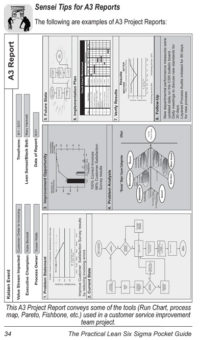
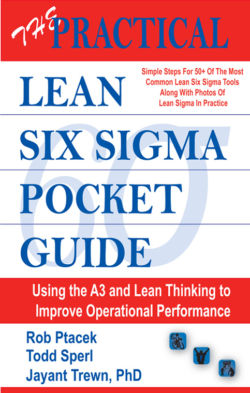 By: Rob Ptacek, Todd Sperl, and Jayant Trewn (PhD) The Practical Lean Six Sigma Pocket Guide is designed as a convenient, quick reference, and, most importantly, a step-by-step implementation guide. You can put your finger on any tool within a matter of seconds! Find the right tool for the right initiative by using the: - Navigate the Prepare - Define - Measure - Analyze - Improve - Control right side book tabs. - Complete the A3 Project Report as you learn and apply the various tools on the project by:
By: Rob Ptacek, Todd Sperl, and Jayant Trewn (PhD) The Practical Lean Six Sigma Pocket Guide is designed as a convenient, quick reference, and, most importantly, a step-by-step implementation guide. You can put your finger on any tool within a matter of seconds! Find the right tool for the right initiative by using the: - Navigate the Prepare - Define - Measure - Analyze - Improve - Control right side book tabs. - Complete the A3 Project Report as you learn and apply the various tools on the project by:- Go to the tab in the book that corresponds to the D-M-A-I-C Phase you are working on.
- Read about the tools for that phase of your project.
- Apply the appropriate tools.
- Complete the relevant section of the A3 Project Report.
- Repeat 1 - 4 as you navigate through the phases and complete your project.
-
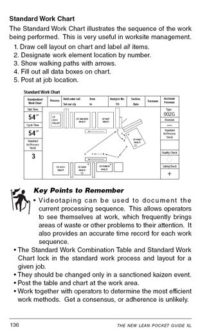
 By: Don Tapping
By: Don Tapping
The New Lean Pocket Guide has over 120 illustrations to visually convey the tools and concepts, along with detailed descriptions of all the Lean tools. This newer version of the best selling The Lean Pocket Guide also includes: a section on Lean Office and Six Sigma, 20+ digital photos demonstrating Lean in action, a Waste Audit, and a Glossary of Lean terms. The tools of 5S, value stream mapping, document tagging, continuous flow, standard work, visual control, takt time, pitch, runners, waste, plus numerous other Lean tools are thoroughly defined as well as guidelines provided for the implementation of each tool. This version has digital photos of Lean production best practices throughout! -
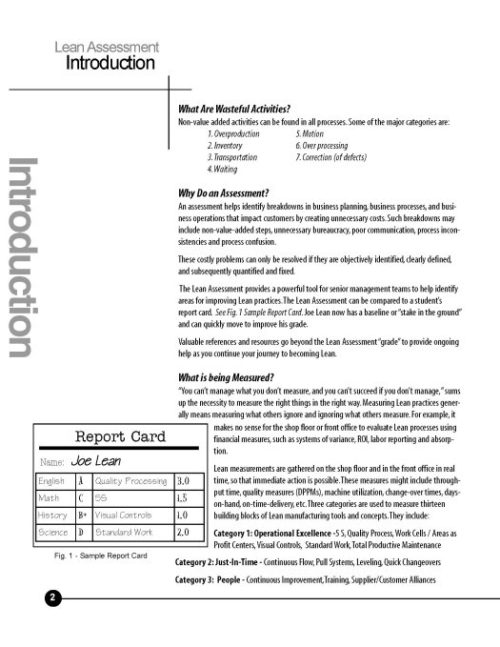
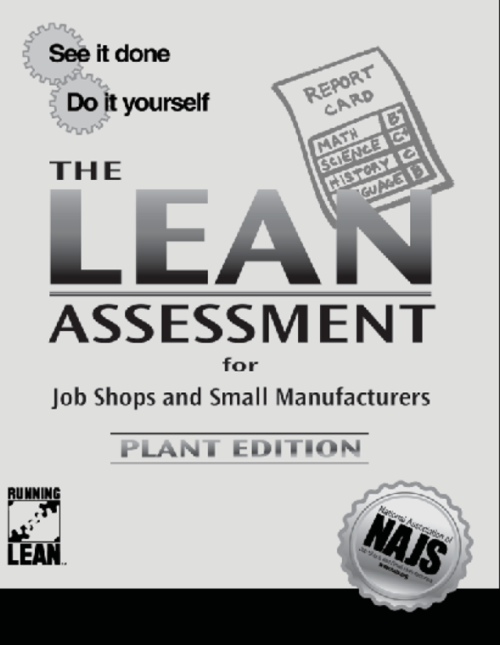 By: Roger Kremer
By: Roger Kremer
The Lean Assessment was created as a guide to allow the job shop and small manufacturer in their Lean journey. The Lean Assessment will provide a baseline upon which you can improve - and most importantly also provide a reference on what to do. The Lean Assessment has 13 Lean building block categories that are further divided into sub-categories that are scored. The subsequent score will assist you into allocating the appropriate resources in your Lean project. Administrative areas are also referenced in this assessment. The Assessment is self-administering and will allow you to create the necessary visual spider chart to convey the score within the organization. -

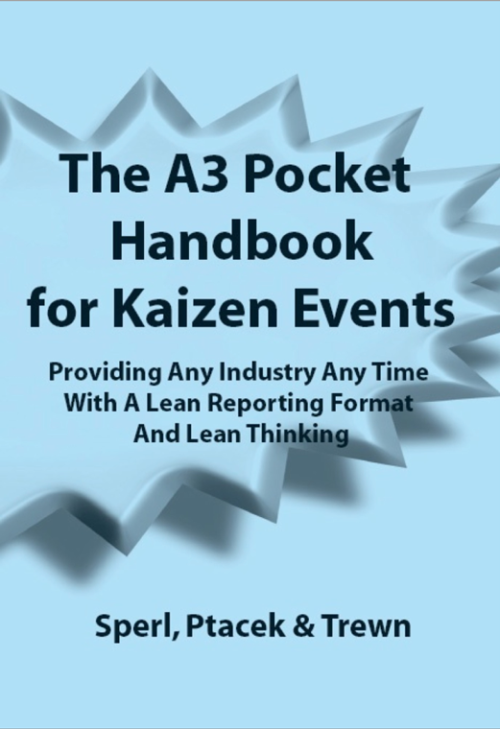 By: Todd Sperl, Rob Ptacek, Jayant Trewn (PhD)The A3 Pocket Handbook for Kaizen Events allows team members to be literally and figuratively on the same page when participating in an improvement event. This allows more ownership, while at the same time preserving organizational knowledge. The improvement methodology used (i.e., Six Sigma D-M-A-I-C, PDCA, etc.) will relate to the A3 Report that is conveyed in this publication. (The A3 Report is designed to help you “tell the story” in a logical and visual way and act as a road map for continuous improvement and problem solving initiatives.) The purpose of this pocket handbook is to:
By: Todd Sperl, Rob Ptacek, Jayant Trewn (PhD)The A3 Pocket Handbook for Kaizen Events allows team members to be literally and figuratively on the same page when participating in an improvement event. This allows more ownership, while at the same time preserving organizational knowledge. The improvement methodology used (i.e., Six Sigma D-M-A-I-C, PDCA, etc.) will relate to the A3 Report that is conveyed in this publication. (The A3 Report is designed to help you “tell the story” in a logical and visual way and act as a road map for continuous improvement and problem solving initiatives.) The purpose of this pocket handbook is to:- Ensure all team members have a quick reference for Lean Six Sigma definitions.
- Compliment, as a mini-workbook, the Practical Lean Six Sigma for Healthcare and The Lean Six Sigma Pocket Guide XL books as well as any other training materials used in an improvement event.
- Provide a road map for continuous improvement projects if no other methodology (i.e., PDCA, D-M-A-I-C, etc.) is used.
- Provide Lean Thinking Statement assessments at the end of each section for employees to “think” Lean and continue their engagement.
- Be a repository of thoughts, ideas, and any action items that may be assigned, etc.
- To retain organizational knowledge by being a personal detailed log of the Kaizen Event to be shared and/or referenced later.
-
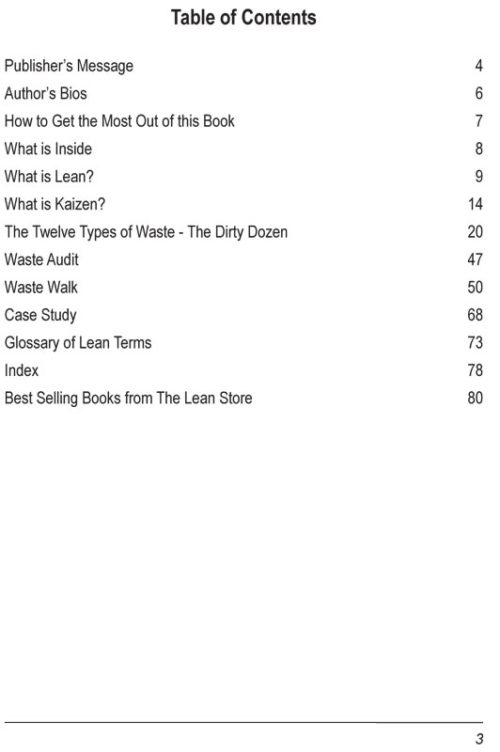
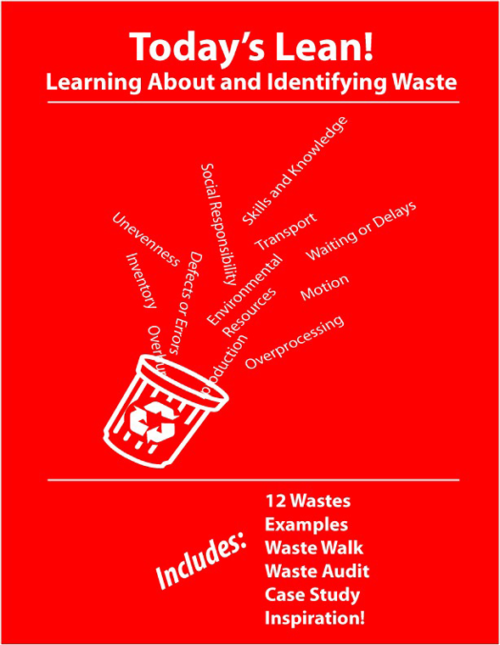 By: Rob Ptacek and Jaideep Motwani (Ph.D.)
By: Rob Ptacek and Jaideep Motwani (Ph.D.)
Today’s Lean! Learning About and Identifying Waste is the first book from the Today’s Lean! series published by MCS Media, Inc. It has been suggested by you, our readers, that you would like Lean and Six Sigma information to be more succinct and at your fingertips, thus allowing for a single tool or concept to be easily accessible (i.e., as a pocket guide and not a manual). Therefore, the Today’s Lean! series of books provide:- Concise content on one main Lean or Six Sigma tool or concept
- Numerous case studies, worksheets, and examples from all types of industries
- Availability as a pocket guide or ebook
- A standard format
- An avenue to update content immediately via your feedback and input (via ebook updates)
- An inspiration for you to implement something similar
-
Out of stock
 First of its kind! The Simply Lean Pocket Guide for Construction is the integration of Lean and the PDCA methodology. The actual case study of Midway Construction demonstrates specifically how problem solving and Lean were used in achieving significant results involving various aspects of the construction industry. The case study - along with the detailed descriptions of the quality improvement tools (with a Lean twist as explained in the case) allows you to take your organization to your next performance level.
First of its kind! The Simply Lean Pocket Guide for Construction is the integration of Lean and the PDCA methodology. The actual case study of Midway Construction demonstrates specifically how problem solving and Lean were used in achieving significant results involving various aspects of the construction industry. The case study - along with the detailed descriptions of the quality improvement tools (with a Lean twist as explained in the case) allows you to take your organization to your next performance level.
NOTE: We are only providing this book as Print On Demand (POD) which requires a minimum order of 100 books. Please call 734-475-4301 to place your order. If you require less than that, please consider The New and Improved Lean Office Pocket Guide or The Simple Lean Pocket Guide.
-

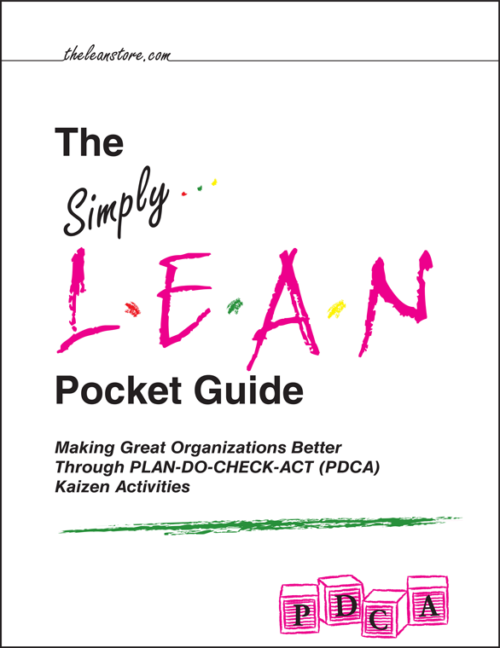 First of its kind! The Simply Lean Pocket Guide is the integration of Lean and the PDCA methodology. The interactive Tinker Town case study allows you to take problem solving with a Lean twist to your next performance level. The most basic premise of Lean is to simply and effectively problem solve. The Simply Lean Pocket Guide is a step-by-step approach to the implementation of process improvements using the PDCA model along with a Lean twist. If you are just beginning to adopt Lean or Six Sigma as a business improvement model, whether you are in the healthcare, financial services, construction, armed services, manufacturing, government, logistics, service, or construction industry, the first thing that should be acknowledged is that the solution to the problem (or improvement target that is to be reached) will be found in the intellect of the people who are working the process. Therefore, as a trainer, consultant (internal or external), or departmental head, the focus to improve a situation would be to “somehow” work with that group (and their intellect) and find a solution. However, that “somehow” is not always easy to attain and will require some guidance along the way.
First of its kind! The Simply Lean Pocket Guide is the integration of Lean and the PDCA methodology. The interactive Tinker Town case study allows you to take problem solving with a Lean twist to your next performance level. The most basic premise of Lean is to simply and effectively problem solve. The Simply Lean Pocket Guide is a step-by-step approach to the implementation of process improvements using the PDCA model along with a Lean twist. If you are just beginning to adopt Lean or Six Sigma as a business improvement model, whether you are in the healthcare, financial services, construction, armed services, manufacturing, government, logistics, service, or construction industry, the first thing that should be acknowledged is that the solution to the problem (or improvement target that is to be reached) will be found in the intellect of the people who are working the process. Therefore, as a trainer, consultant (internal or external), or departmental head, the focus to improve a situation would be to “somehow” work with that group (and their intellect) and find a solution. However, that “somehow” is not always easy to attain and will require some guidance along the way. -
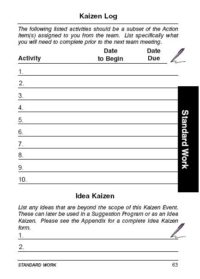
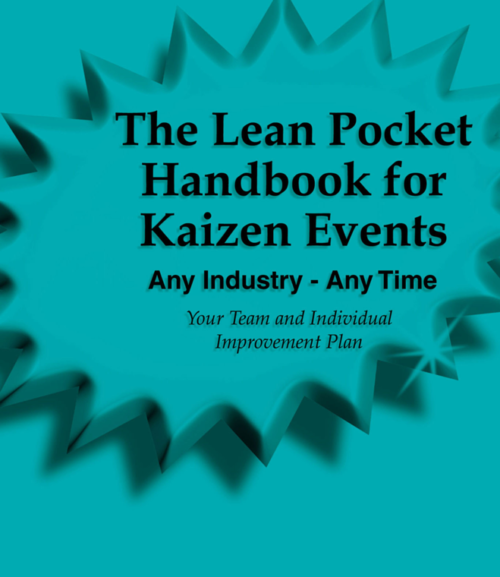 The Lean Pocket Handbook for Kaizen Events is your personal (i.e., individual) Lean planner for the 21st century. We have found individuals that use this pocket handbook feel more part of the Kaizen team. They also continue to contribute improvement ideas well past the formal team Kaizen Event. That is what Lean is all about - making those small, incremental, improvements daily (i.e., hour-by-hour and minute-by-minute) by those closest to the process.This handbook is designed to be:
The Lean Pocket Handbook for Kaizen Events is your personal (i.e., individual) Lean planner for the 21st century. We have found individuals that use this pocket handbook feel more part of the Kaizen team. They also continue to contribute improvement ideas well past the formal team Kaizen Event. That is what Lean is all about - making those small, incremental, improvements daily (i.e., hour-by-hour and minute-by-minute) by those closest to the process.This handbook is designed to be:- A quick-reference guide. Lean tools are explained in more detail in other manuals or by your facilitator during the instruction portion of the workshop.
- Your individual (i.e., personal) log. When working outside the formal training class, notes and ideas about the area or process that are being analyzed can be easily written down in this handbook (serving as your personal log) so as not to lose valuable process information.
- Your personal Kaizen planner. Kaizen Events will require that individual tasks be assigned to team members to be completed prior to the next meeting. Many of these tasks will need to be scheduled within the individual’s current work day. This handbook will thus serve as your “planner” to assure these tasks are adequately planned and completed on time.
- A tool to self-initiate Idea Kaizens. An Idea Kaizen is an individual that implements an improvement with little or no assistance or resource required. This is similar to a Suggestion Program submission; however, the individual with the Idea Kaizen would be responsible for immediate implementation of the idea.
- A learning tool. Each tool will have illustrations to graphically represent the essence of each tool. This will allow you to better understand and learn about each tool prior to using them in your Kaizen Event.
-
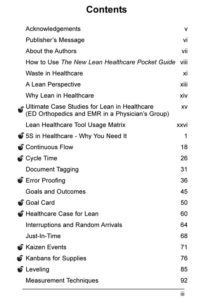
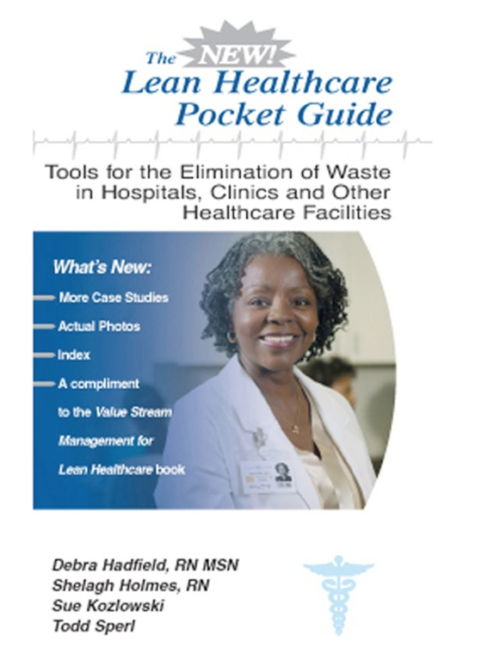 By: Debra Hadfield (RN MSN), Shelagh Holmes (RN), Sue Kozlowski, Todd Sperl, and Don TappingThe New Healthcare Pocket Guide is a collection of input from healthcare professionals and Lean Sensei. It provides easy-to-use and easy-to-understand tools, methods, and concepts based on the world-class Toyota Motor Company (i.e., Lean). The New Lean Healthcare Pocket Guide is design for use as a quick and easy reference as you learn and implement Lean tools. The tools of 5S, continuous flow, cycle time, document tagging, error proofing, goals and outcomes, Just-In-Time, takt time, standard work, pitch, plus all the other Lean tools are thoroughly explained. This “newer” version includes additional case studies, actual photos, an index, as well as compliments the Value Stream Management for Lean Healthcare book. This book will assist any healthcare facility in the enabling them into a Lean environment where the focus is on both driving strategic change and meeting operational goals.
By: Debra Hadfield (RN MSN), Shelagh Holmes (RN), Sue Kozlowski, Todd Sperl, and Don TappingThe New Healthcare Pocket Guide is a collection of input from healthcare professionals and Lean Sensei. It provides easy-to-use and easy-to-understand tools, methods, and concepts based on the world-class Toyota Motor Company (i.e., Lean). The New Lean Healthcare Pocket Guide is design for use as a quick and easy reference as you learn and implement Lean tools. The tools of 5S, continuous flow, cycle time, document tagging, error proofing, goals and outcomes, Just-In-Time, takt time, standard work, pitch, plus all the other Lean tools are thoroughly explained. This “newer” version includes additional case studies, actual photos, an index, as well as compliments the Value Stream Management for Lean Healthcare book. This book will assist any healthcare facility in the enabling them into a Lean environment where the focus is on both driving strategic change and meeting operational goals.

